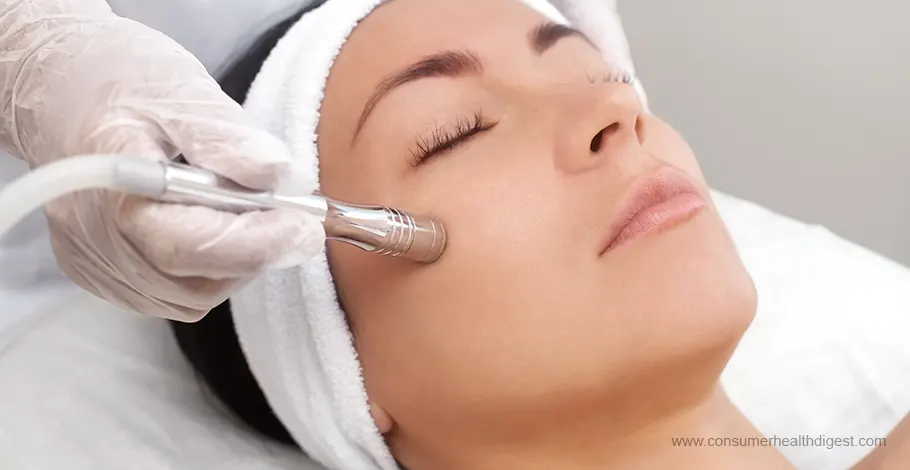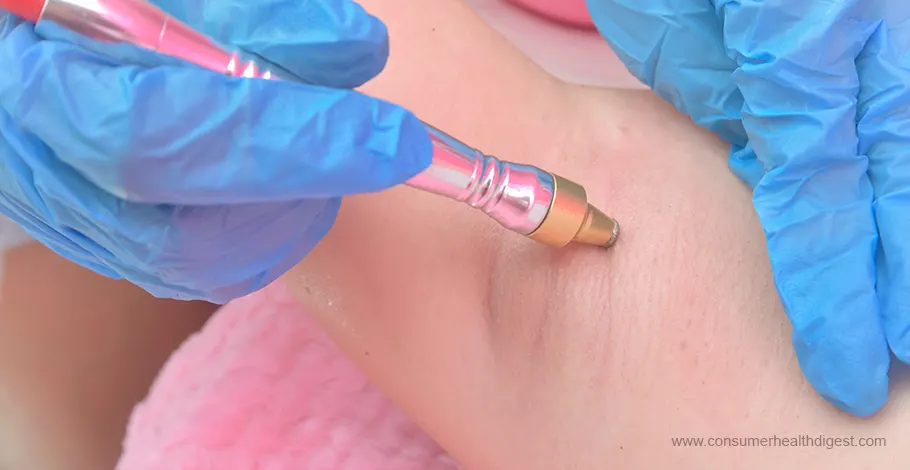In the modern landscape of aesthetic treatments and skin rejuvenation, microdermabrasion emerges as a distinguished contender, particularly in its application for enhancing skin quality and appearance. This gentle yet effective procedure utilizes fine crystals or a diamond-tipped wand to exfoliate the outer layer of the skin, paving the way for a newer, healthier skin surface.

Our focus on “Microdermabrasion for Stretch Marks” not only explores this innovative treatment option but also underscores its significance in transforming skin texture and appearance. Understanding the mechanics behind microdermabrasion, paired with insight into its specific application for diminishing the appearance of stretch marks, provides a foundation for appreciating its role in modern dermatology.
Here, we introduce you to a deeper understanding of how microdermabrasion can work wonders in revitalizing stretched skin fibers, thereby fostering a more toned, smoother skin appearance. The importance of familiarizing oneself with this process cannot be overstated, as it holds the key to unlocking a more confident and refreshed skin surface.
Understanding Stretch Marks
What are stretch marks?
Stretch marks, or striae, represent a common skin condition where bands of linear scars appear on the body. These marks materialize when our skin stretches or shrinks rapidly, disrupting the normal production of collagen and elastin, which are crucial for maintaining skin’s elasticity. Despite being harmless from a medical standpoint, they carry considerable cosmetic concern for those affected. [1]
Causes and common locations
The inception of stretch marks can be attributed to several life events that induce rapid changes in body size. Pregnancies, puberty-induced growth spurts, significant weight fluctuations, and muscle mass increases due to intense physical training are common precursors.
This dermal tearing predominantly appears in areas predisposed to fat accumulation, such as the abdomen, breasts, hips, thighs, and buttocks. Genetic predisposition also plays a vital role, indicating that if your family members have stretch marks, you’re more likely to develop them as well.
Impact on skin appearance and self-confidence
Stretch marks often present as reddish, purple, pink, or dark brown streaks, transitioning to a lighter, more scar-like appearance over time. While they are physically painless, their presence can significantly impact an individual’s perception of their skin appearance and overall self-confidence.
Many report feeling self-conscious or less confident in their skin, leading to a reduced quality of life in severe cases. Addressing stretch marks is thus not only a matter of skin health but also of emotional wellbeing, underscoring the importance of effective treatment solutions like microdermabrasion for those seeking to minimize their appearance. [2]
Exploring Microdermabrasion

Does Microdermabrasion Remove Stretch Marks? Shutterstock Image
Microdermabrasion stands as a beacon of hope for those seeking to diminish the visibility of stretch marks, leveraging its non-invasive nature to restore skin confidence. This cosmetic procedure exfoliates the skin’s upper layer using a specialized device, effectively removing dead skin cells and promoting the rejuvenation of new cells. The treatment’s essence lies in its simplicity and efficiency, offering a gateway to improved skin texture and appearance without the need for invasive surgery.
How Microdermabrasion Works
At its core, microdermabrasion utilizes fine crystals or a diamond-tipped wand to gently buff away the outermost layer of the skin. This action not only clears away dead skin cells but also kick-starts the body’s natural processes to enhance collagen production. Collagen, a critical protein for skin elasticity and health, plays a pivotal role in the skin’s healing process, potentially making stretch marks less noticeable.
Different Types of Microdermabrasion Techniques
The versatility of microdermabrasion is evident through the existence of various techniques, each tailored to meet specific needs and preferences. The two primary methods include:
Crystal microdermabrasion [3], which blasts tiny crystals across the skin for exfoliation;
Diamond-tip Microdermabrasion [4], which uses a diamond-encrusted tip to exfoliate the skin more directly.
Both methods are effective, and the choice between them often boils down to the individual’s skin type and the practitioner’s recommendation.
Safety Considerations and Potential Risks
While microdermabrasion is celebrated for its minimal downtime and low risk, it is imperative to acknowledge potential side effects and safety considerations. Common side effects include mild tenderness, redness, and swelling immediately after the procedure, usually subsiding within a few hours.
It is crucial for individuals to select certified practitioners and discuss their skin history beforehand to mitigate risks of adverse reactions. Pre-treatment and post-treatment skin care, tailored to protect and nurture the skin, further enhances the treatment’s safety and efficacy.
Microdermabrasion for Stretch Marks
Microdermabrasion’s efficacy in treating stretch marks lies in its ability to expedite the skin’s natural regeneration process. By removing the outermost layer of dead skin cells, it stimulates the production of new, healthy cells and increases collagen and elastin synthesis – crucial components in improving skin elasticity and reducing the visibility of stretch marks.
Research suggests that regular microdermabrasion treatments can noticeably diminish the appearance of stretch marks, with many individuals observing improvements within a few weeks to several months of consistent treatment. However, results and timelines can vary based on an individual’s skin type, the age and severity of the stretch marks, and adherence to a recommended treatment schedule. [5]
Dr. Anna Chacon, Dermatologist explains that microdermabrasion is a non-invasive procedure that uses tiny crystals to exfoliate and remove the superficial layer of dry, dead skin cells. By removing the top layer of skin, the body quickly replaces the lost skin cells with new, healthier ones. This process stimulates blood flow, boosts collagen production, and improves skin elasticity and texture, which can help reduce the appearance of stretch marks.
It’s pertinent for individuals to consult with a skincare professional to assess their skin’s condition and receive a tailored treatment plan. This is especially important for those with sensitive skin or darker skin tones, as they may experience different results or require a modified approach to avoid pigmentation changes.
Through a personalized assessment, professionals can optimize treatment parameters to ensure safety, minimize potential risks, and achieve the most favorable outcomes for each unique skin type and tone.
Other Benefits of Microdermabrasion
- Enhanced Skin Texture: Beyond diminishing stretch marks, microdermabrasion significantly smooths and refines skin texture, offering a youthful and vibrant complexion.
- Reduction of Fine Lines and Wrinkles: Through its exfoliating process, microdermabrasion effectively minimizes the appearance of fine lines and wrinkles, promoting a more youthful look.
- Improved Skincare Product Efficacy: Post-treatment, the skin exhibits an increased capacity to absorb and benefit from skincare products, thanks to the removal of dead skin layers which typically hinder penetration.
This array of benefits underscores microdermabrasion’s versatility as a skincare treatment, catering not only to those seeking improvement in skin texture and the reduction of aging signs but also enhancing the performance of skincare regimens.
Alternative Treatments for Stretch Marks

Laser Therapy for Face. Shutterstock Image
- Topical Remedies: A variety of creams are designed specifically to combat stretch marks, aiming to diminish their visibility.
- Laser Therapy: This advanced treatment option employs laser technology to noticeably reduce the appearance of stretch marks.
It’s crucial to remember that skin health and responses to treatments vary from person to person. Opting for microdermabrasion or investigating alternative methods, it’s comforting to know there are multiple paths to address stretch marks.
Conclusion
In conclusion, microdermabrasion stands as a proven, safe, and effective option for those looking to combat stretch marks and rejuvenate their skin. By harnessing the power of advanced technology to stimulate collagen production and enhance product penetration, this treatment offers a non-invasive route to noticeable skin improvement.
Individuals seeking to restore their skin’s elasticity and reduce the appearance of stretch marks can rely on microdermabrasion for results that not only look good on the surface but also promote healthier skin from within.
With its impressive track record and comprehensive benefits, microdermabrasion is undeniably a promising path to skin rejuvenation and personal renewal. Thus, for anyone aiming to achieve a smoother, more youthful appearance, microdermabrasion presents a compelling choice worth considering.
5 Sources
We review published medical research in respected scientific journals to arrive at our conclusions about a product or health topic. This ensures the highest standard of scientific accuracy.








 This article changed my life!
This article changed my life! This article was informative.
This article was informative. I have a medical question.
I have a medical question.
 This article contains incorrect information.
This article contains incorrect information. This article doesn’t have the information I’m looking for.
This article doesn’t have the information I’m looking for.